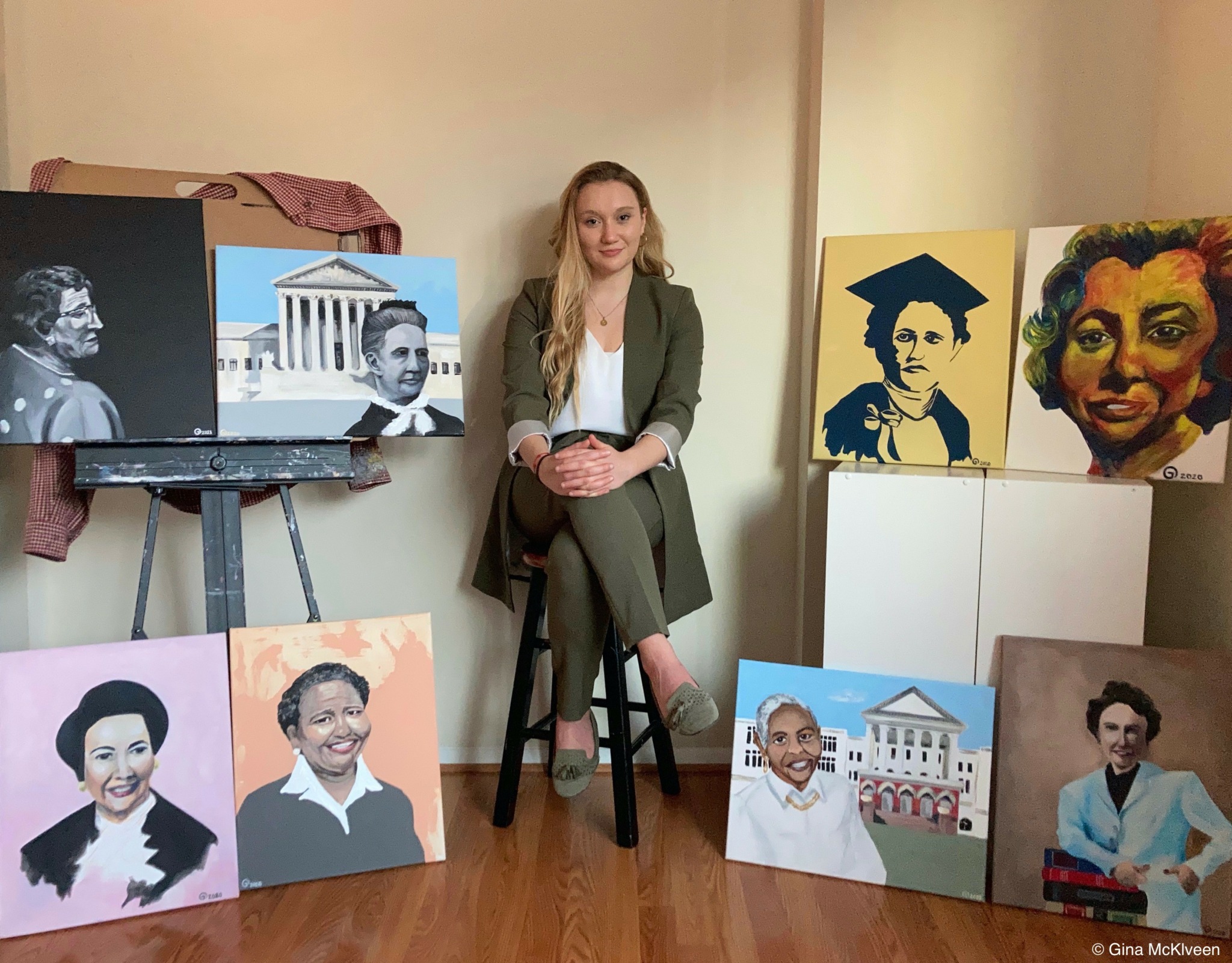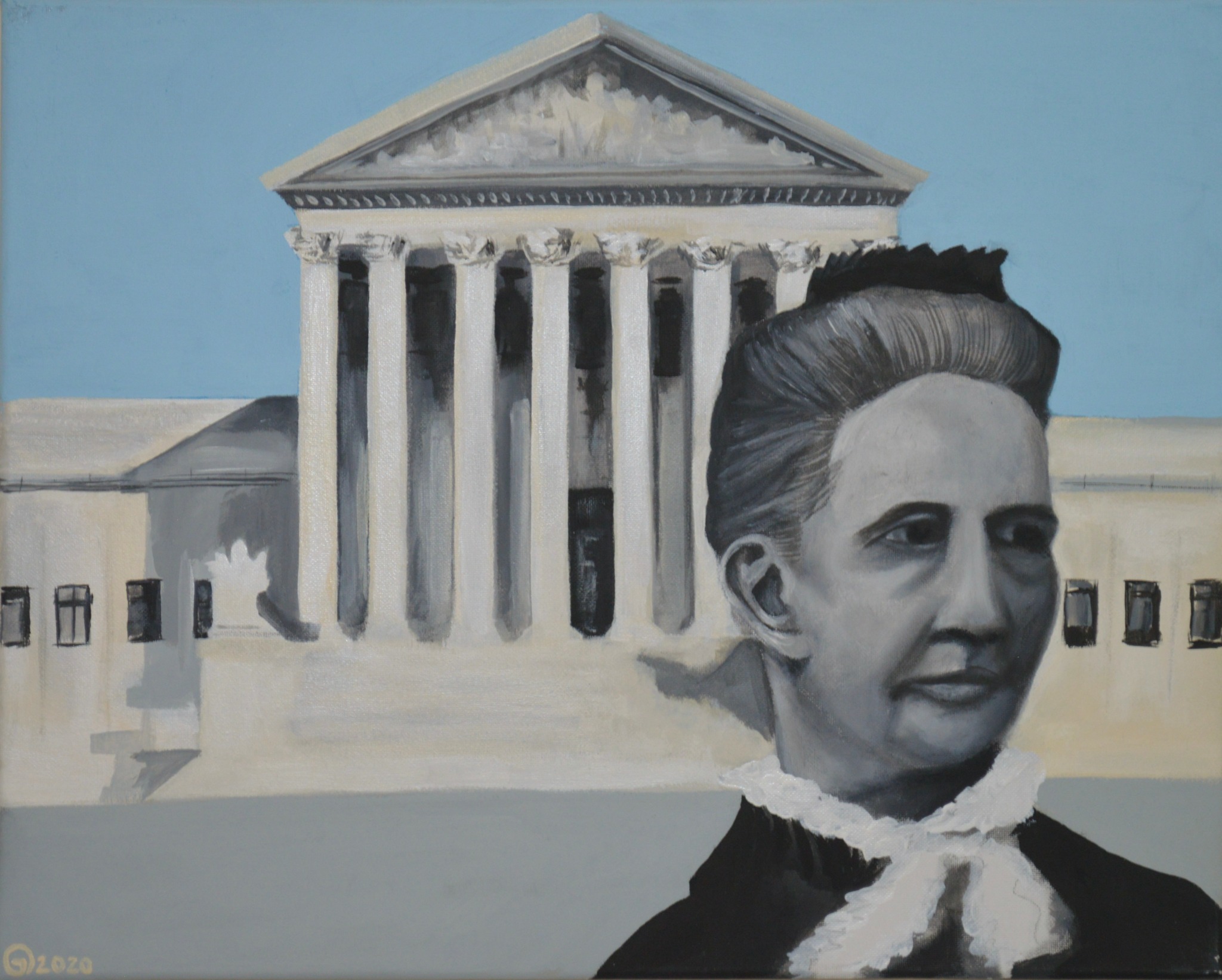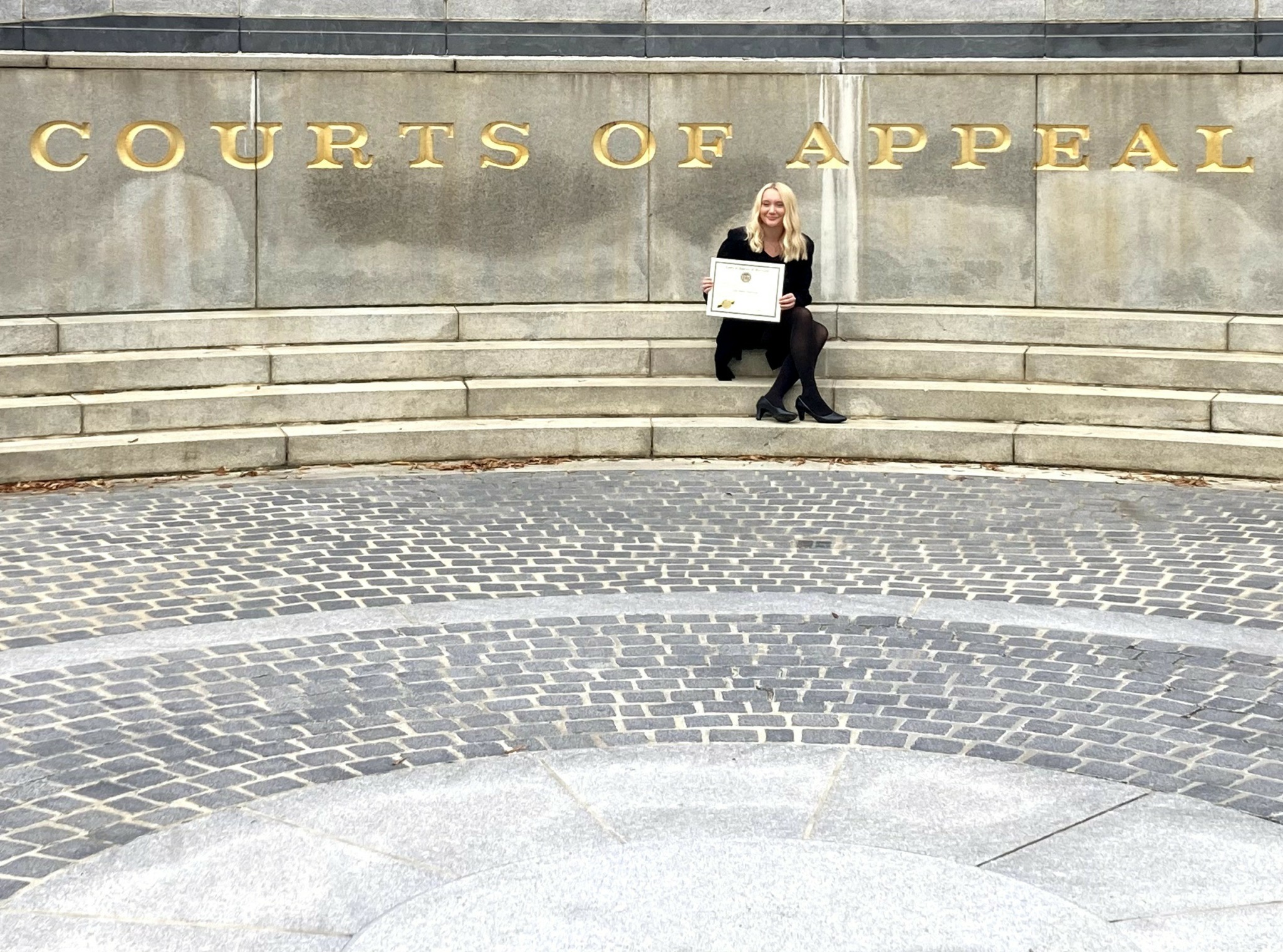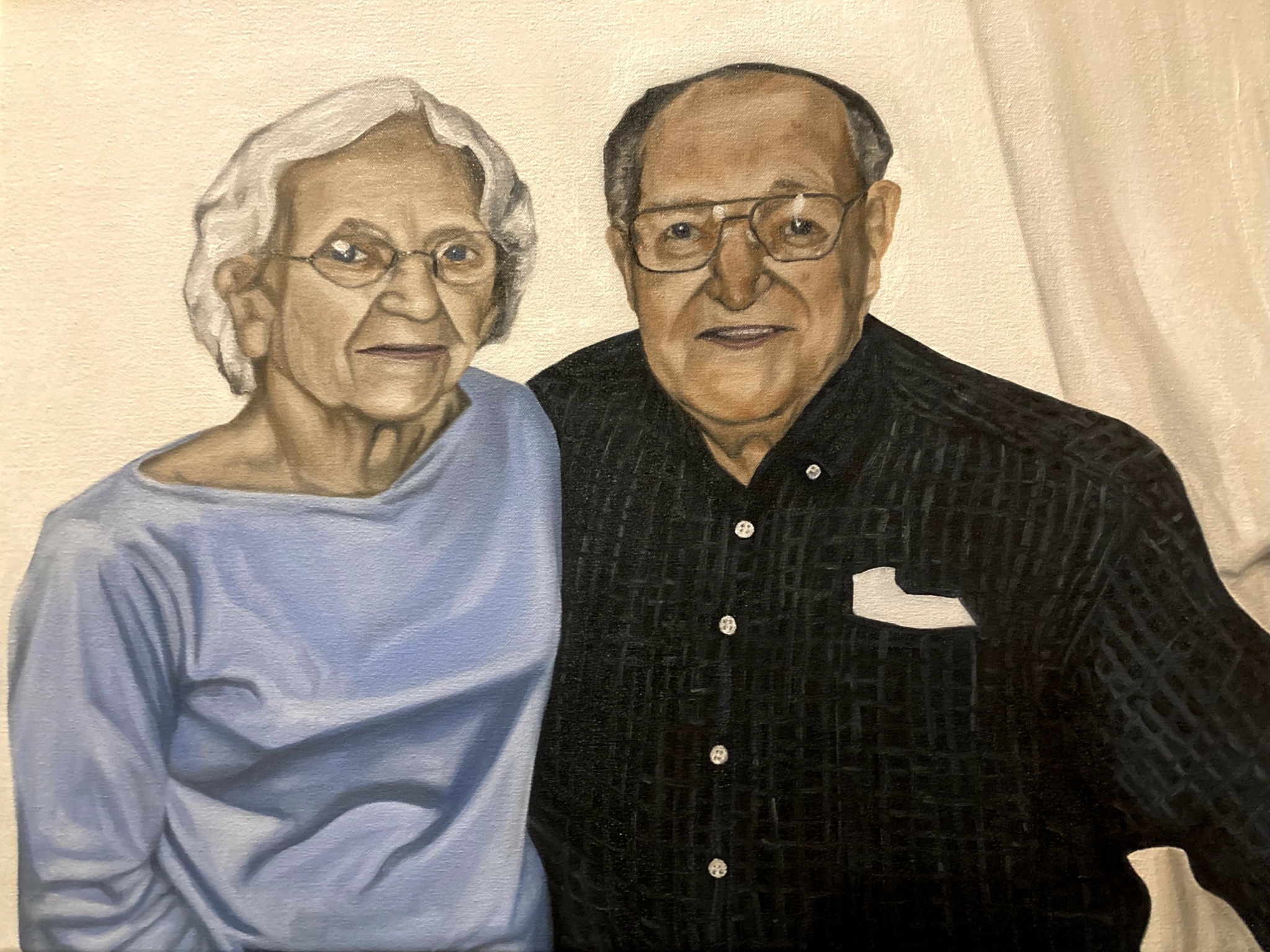We’re excited to introduce you to the always interesting and insightful Gina McKlveen. We hope you’ll enjoy our conversation with Gina below.
Gina , looking forward to hearing all of your stories today. We’d love to hear the backstory behind a risk you’ve taken – whether big or small, walk us through what it was like and how it ultimately turned out.
When I graduated from a small liberal arts college in 2017 with dual bachelor of arts degrees in English Literature and Studio Art, I decided to take what felt like the biggest step in my life at the time and applied to law school. I was a first-generation college graduate, but graduating from law school would make me the first-ever attorney in my entire family. Law school was something no family member had attempted before me. As the youngest person in my immediate family and the youngest grandchild on both maternal and paternal sides, I was used to having footsteps to follow–whether it was an older brother or older cousins, numerous aunts and uncles, my own mom and dad, or any of my four grandparents–I had plenty of people to look up to and learn from.
However, by 2018, I wanted to chart my own path, do something that hadn’t been done before, and try something new. I sat for the LSAT three separate times, scoring about the same average score each time, which was an incredibly frustrating (and expensive) result after completing a course that offered little, if any, improvement. I sent applications to several law schools around the country, covering local law schools, schools on both east and west coasts, and even some in the mid-west. Rejections and acceptances trickled in over the first several months. Early on, I received a letter notifying me that I had been waitlisted at The George Washington University Law School–a school in my dream city of Washington, DC. I was faced with a dilemma: What do you do when you are waiting on your dreams to come true?
From March 2018 until August 2018, I made several trips to the nation’s capital. First, visiting the The George Washington University Law School (GW Law) campus, walking around the University Quad, taking in the metropolitan area and its history being just a few blocks from The White House; then, meeting with the Dean of Admissions, immediately admiring her children’s artwork hanging around her office, giving her supplemental application materials like my art portfolio, and trying my hardest to convince her of what I already knew, which was that I belonged at this school. I went as far as to ask personal connections to reach out to the Dean of Admissions office as well, writing letters of recommendation on my behalf, hoping their words would lend to my credibility and qualifications. With every trip and phone call I made to the Admissions Office at GW Law, I made a case for myself to be admitted, but in the waiting my self-doubt increased. If the goal was just to go to law school, I had other options, mostly local schools that had accepted me and even provided some scholarship opportunities. I was getting advice in every direction, some advising me, wittingly, that the best ship in the sea is the scholarship, others cautioning that where I chose to pursue my next educational step would likely become the basis for my professional network. So, I toured the local schools out of obligation, but felt nothing for them–none of the excitement nor the feeling of belonging that I had when I dreamed of attending and graduating from GW Law. I had a conversation with a close friend, who helped me make a pact to never settle, and with that I dove in headfirst, telling myself that it had to be DC and it had to be GW Law.
Around the first week of August of 2018, I was back in DC for a job interview with Amnesty International. As luck, life, or fate would have it, the interviewer was familiar with my small town area and we connected over that location in a way that allowed him to level the conversation. He asked me what was drawing me to Washington, DC. In the course of answering his question, I mentioned that I was still waitlisted at GW Law. Upon hearing this, he encouraged me to stop over at the Admissions Office after we wrapped up the interview. Had he not said that, I doubt I would have gone to GW Law that day. But I drove over to campus one last time, stopped in the Admissions Office and spoke to the work-study student sitting at the desk by the door. I asked him if there had been any movement on the waitlist. He didn’t have an answer for me. I left him with my name and requested that he let the Dean of Admissions know I was still waiting to hear from her. He said he would. I drove back from Washington, DC that day relieved, knowing that no matter what at least I had done everything I possibly could to fulfill my dream. The next day, I traveled to one of the local law schools I was admitted, but had not yet accepted, to tour apartments. I was considering signing a lease, when I got an email from the Dean of Admissions at GW Law notifying me that I was no longer waitlisted. I had finally been accepted to GW Law.
It was a risk saying yes to GW Law–I had no scholarship to attend, meaning I’d be paying the full-price of tuition; I had to move to a new city and away from my village, meaning both my close-knit family and the small, rural town I had lived in all my life; and I would be the first one in my family to attempt this path, meaning there were no footprints for me to follow. In two short weeks, I packed up my things and left my life behind to begin this new journey. Over the next three years, I was challenged in ways that had me constantly questioning my abilities, my intelligence, and frankly, my choices. After my first semester at GW Law, I thought I made a major mistake and applied to art school–I was denied. Thankfully, I had people in my life and network encouraging me to stay the path. So, I continued on my 2L year, becoming the President of the Law Association for Women at GW Law and experiencing my “lightbulb moment” when my purpose for attending law school was ignited in a copyright law course, realizing that combining my two passions for art and law could be united in this type of advocacy. Just when I felt like I was hitting my stride, the COVID-19 outbreak commenced and my law school education, like everything else, was disrupted.
The remainder of my law school experience was entirely online. I did my best to make the most of it, even curating the first-ever virtual art exhibition at GW Law, which I titled “NINE: Portraits of Women in the Law,” honoring the lives and legacies of women who had graduated from GW Law and contributed to the legal profession. This was another example of my combination of art and law, showing myself and others that these two fields could co-exist in a meaningful way. It was through the process of researching and organizing this exhibition that all the risks in choosing GW Law, and becoming an attorney became worth it for me because I learned that the first woman to graduate from GW Law was named Belva Ann Lockwood, who was a trailblazing woman, becoming the first woman to argue before the Supreme Court of the United States during a time when women had yet to gain the right to vote. Learning about Belva Ann Lockwood was significant in that my own mother’s name is also Belva–at the time I had never known of anyone who shared the same unique name as my mother–I felt this connection to both Belvas that seemed to justify to me this is why I was meant to go to GW Law, as opposed to any other law school and this is why I was meant to become an attorney, for the other women in my family, who did not have the same opportunities.
Since graduating from GW Law in 2021, I have become a licensed attorney in three states–Maryland, Pennsylvania, and New York–and I can proudly say that I am the first attorney in my family. Every day in my work, I think of my grandmothers, who never had the opportunity to complete even their high school education because familial responsibilities and societal expectations took precedence. My hope is that the reward for the risk that I took is reflected in future generations of my own family–that because I forged a path, previously unchartered, that others will have a guidepost in me–that I can be someone to look up to and learn from just like my family has been for me.

As always, we appreciate you sharing your insights and we’ve got a few more questions for you, but before we get to all of that can you take a minute to introduce yourself and give our readers some of your back background and context?
Although I consider myself equal parts artist and attorney, at the end of the day I am just Gina. As I said, I grew up being the youngest person in a relatively-large, close-knit family. My hometown is quite literally categorized as a village and I was raised by a village, too–within walking distance to both sets of grandparents’ houses and surrounded by nature, which allowed for regular outdoor adventures and gorgeous rolling hillside scenery. Having so much beauty and open space literally in my backyard could have inspired my own appreciation for all things involving beauty and creation. I’ve been the creative kid all my life–constantly crafting with anything I could get my hands on. Growing up, my grandmother taught me to sew clothes for my dolls, my aunts and uncles inspired me with their knack for poetry and music, and my mother, although baffled by my artistic talents, claiming I never drew a stick figure always depicting full-bodied people, encouraged my creative tendencies by signing me up for art classes and purchasing my very, first set of art supplies.
Despite all the things I love about my upbringing, unfortunately, small towns do not always have overwhelming access to arts and culture. I believe this is where my passion for advocacy, especially arts advocacy, was developed. The first time my parents set foot in an art museum was when one of my artworks was selected to be in the student art show at the local gallery. From this, I experienced first-hand how art had the ability to open up the world to me and to the people around me. In my public education, I witnessed funding for the arts become diminished and deferred to STEM projects and stereotypically, to the high school football program. Likewise, in college, resources for my fellow English and Studio Art majors were neglected, while facilities were expanded for the science department. Thankfully, my alma mater has since redressed this lack of resources, as a new library and art gallery is now apart of the updated college campus. Nevertheless, it has become increasingly important to me to use my position as an attorney to advocate for artists, artworks, and art programs, as each of these is a vital part of a holistic community.

What can society do to ensure an environment that’s helpful to artists and creatives?
Access, resources, and education are some of the most basic tenets to creating a society where artists and creative industries are not only supported, but where they can thrive. In 2022, the United States Congress House of Representatives Small Business Committee held a first of its kind hearing on the vital role the creative economy has in America. The purpose of this hearing was largely connected to the impact the COVID-19 pandemic had on artists and the creative industry as a whole. As communities suffered in the pandemic, the artists and creatives were providing the inspiration and relief to carry the morale through, while also suffering from lost jobs, cancelled shows, and depleted funding. Moreover, when budget proposals were revised in the months of the pandemic and after, arts programs were some of the first cuts made. Currently, further financial cuts are taking place as a result of the new U.S. executive administration’s efforts to downsize the federal government, slashing the Department of Education, and withholding federal funds to organizations with diversity, equity, and inclusion efforts or other initiatives that oppose the administration’s controversial agenda.
At these moments, I often think of the quote from The Dead Poets Society by John Keating, “We don’t read and write poetry because it’s cute. We read and write poetry because we are members of the human race. And the human race is filled with passion. And medicine, law, business, engineering, these are noble pursuits and necessary to sustain life. But poetry, beauty, romance, love, these are what we stay alive for.” Simply put, society needs to value the arts as the noble pursuit that it is. To do this, artists, art education, and art programs need funded, not defunded. The way to do this is also simple and multi-faceted, support creatives and creative industries, join boards of nonprofits, donate to local art organizations, enroll yourself and your kids in art classes, buy artwork from independent artists. In a world that is starving artists, society needs to make sure the arts are also fed.

We’d love to hear your thoughts on NFTs. (Note: this is for education/entertainment purposes only, readers should not construe this as advice)
I think NFTs, like any new type of technology, has its problems and also has its potential. In 2021, when NFTs took the mainstream media by storm, I was able to get in on the ground-level of teaching a few lectures at colleges and universities on this subject. In these lectures I addressed the pros and cons of NFTs across various industries. Personally, one of the strongest cons I see with NFTs are the overall lack of regulation. The law is often slow to adapt to new technology, which can certainly allow for innovation, but the concern is that without structure there can be no enforcement. By this, my greatest concern is how NFTs can be thwarted to harm artists and creatives, such as blatantly infringing their works, circumventing an artist’s rights to own their works through one-size fits all smart-contracts or be fairly compensated by resale rights and royalties automatically imbedded in these contracts. On the flip side there are also pros to this type of technology, such as the fact that there are royalties to be made upon transfer of an NFT, rather than in the physical art market, where an artist’s ability to be compensated on subsequent transfers of an artwork may be subject to the first-sale doctrine. In this way, I often equate NFTs in digital art to streaming or purchasing a digital copy of a song in music. Generally, I believe once the appropriate legal structures are in place, NFTs can be harnessed in a powerful way to form another revenue stream for artists, providing greater profit potential on their artworks. Like all technology, only time will tell how NFTs may influence our world and the artist/audience experience.
Contact Info:
- Website: https://ginamcklveen.substack.com/
- Instagram: https://www.instagram.com/imaginaartist/
- Linkedin: https://www.linkedin.com/in/gina-m-b283361a1/





